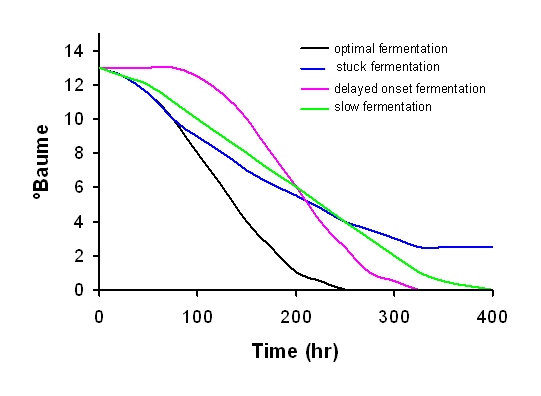[I apologize in advance for crossposting this, but I realized too late that the thread I posted it to on a different forum was dead. I'll ask the moderator there to delete it, and this will now be the official thread.]
I've started making my first wine fermentation using bread yeast. From some googling I've read that the ideal fermentation temperature for bread yeast is 95F (but the same question applies--see below--about Premier Cuvee wine yeast). Being impatient, I want this fermentation to go as quickly as possible. Is there anything wrong with fermenting the wine at 95F? I'm able to control the "must" temperature to within 1F, and I can dial in any temperature that I want to. That's because I have the fermentation vessel sitting in a water bath, and I can control the water bath temperature to within 1 degree with a thermostat control and a temperature probe. I just wanted to be crystal clear that I'm *not* talking about ambient air temperature, but rather the temperature of the "must" itself.
Please advise.
[Edit:
Here's the link about the optimal temperature for bread yeast (from its perspective) being 95F: (... sorry the forum software won't let me post the link because it thinks it may be spam). It also graphs how fermentation speed increases with temperature.
Of course, wine isn't bread, but wouldn't the yeast be happiest at the same 95F regardless of what the growth medium is? Well, I can only guess, which is why I'm asking.
When I've read forum posts about wine fermenting temperatures, the answers that typically get posted are of the form "Well, *I* like to ferment at X temperature, and so that's what I recommend for you." The trouble with that is that it's just some unknown guy's opinion, and for all I know he never tried a different temperature, or else maybe arrived at that conclusion from noisy data. So, what I'm looking for here is some science in the answer, not just a string of anecdotes.
The problem with looking at the spec sheet for a wine yeast (which I'll try in the next batch) is that it gives a fermentation *range*. It doesn't come out and say what the most optimal temperature is in that range. So, for example, the Premier Cuvee wine yeast (and I was going to post a link here to the specsheet, but again was prevented) has a temperature range of 45F-95F. But does that mean anything in that range is perfectly fine (in which case, why go slow when you can go fast), or is optimal near the midpoint, or....? ]
I've started making my first wine fermentation using bread yeast. From some googling I've read that the ideal fermentation temperature for bread yeast is 95F (but the same question applies--see below--about Premier Cuvee wine yeast). Being impatient, I want this fermentation to go as quickly as possible. Is there anything wrong with fermenting the wine at 95F? I'm able to control the "must" temperature to within 1F, and I can dial in any temperature that I want to. That's because I have the fermentation vessel sitting in a water bath, and I can control the water bath temperature to within 1 degree with a thermostat control and a temperature probe. I just wanted to be crystal clear that I'm *not* talking about ambient air temperature, but rather the temperature of the "must" itself.
Please advise.
[Edit:
Here's the link about the optimal temperature for bread yeast (from its perspective) being 95F: (... sorry the forum software won't let me post the link because it thinks it may be spam). It also graphs how fermentation speed increases with temperature.
Of course, wine isn't bread, but wouldn't the yeast be happiest at the same 95F regardless of what the growth medium is? Well, I can only guess, which is why I'm asking.
When I've read forum posts about wine fermenting temperatures, the answers that typically get posted are of the form "Well, *I* like to ferment at X temperature, and so that's what I recommend for you." The trouble with that is that it's just some unknown guy's opinion, and for all I know he never tried a different temperature, or else maybe arrived at that conclusion from noisy data. So, what I'm looking for here is some science in the answer, not just a string of anecdotes.
The problem with looking at the spec sheet for a wine yeast (which I'll try in the next batch) is that it gives a fermentation *range*. It doesn't come out and say what the most optimal temperature is in that range. So, for example, the Premier Cuvee wine yeast (and I was going to post a link here to the specsheet, but again was prevented) has a temperature range of 45F-95F. But does that mean anything in that range is perfectly fine (in which case, why go slow when you can go fast), or is optimal near the midpoint, or....? ]


